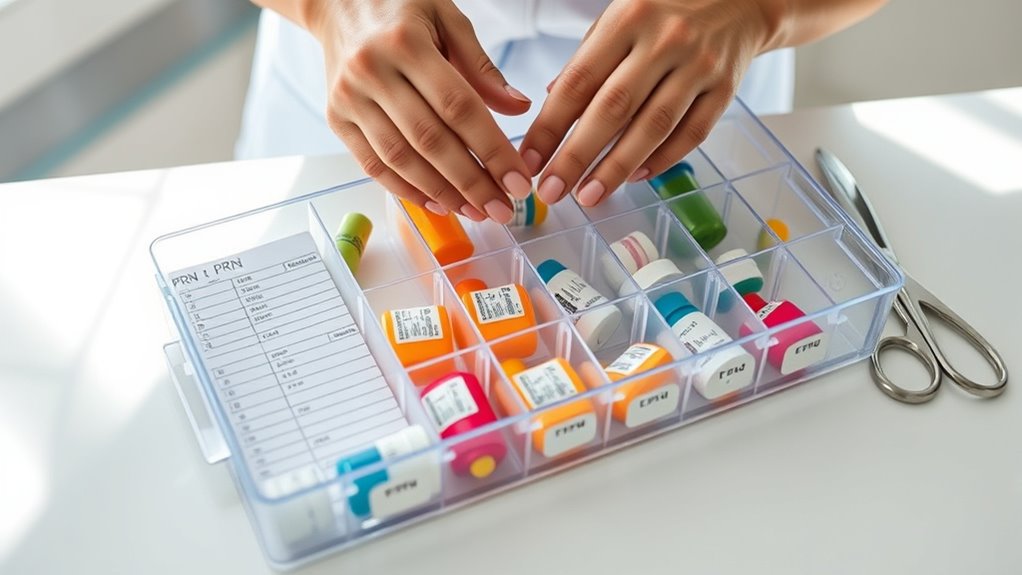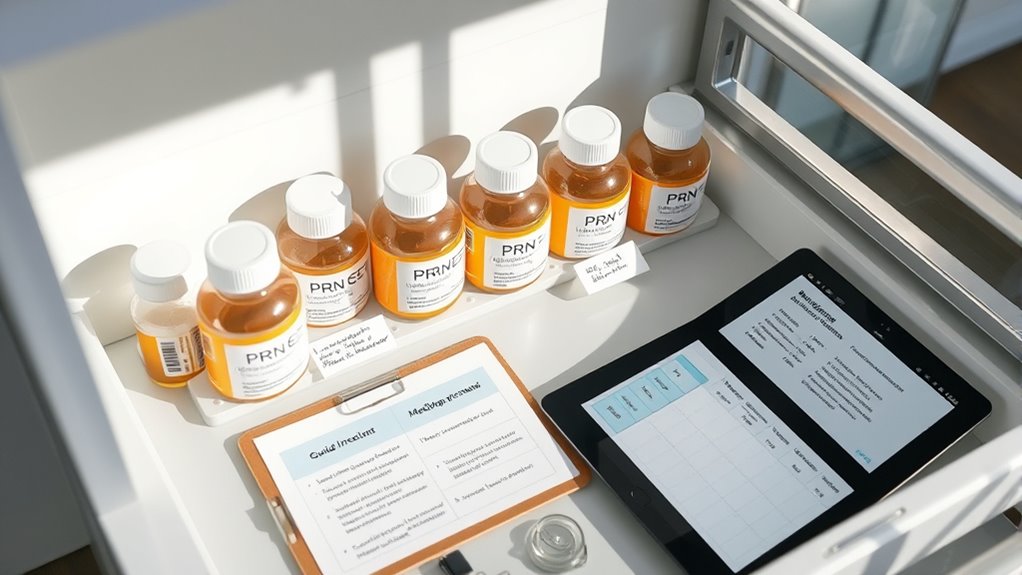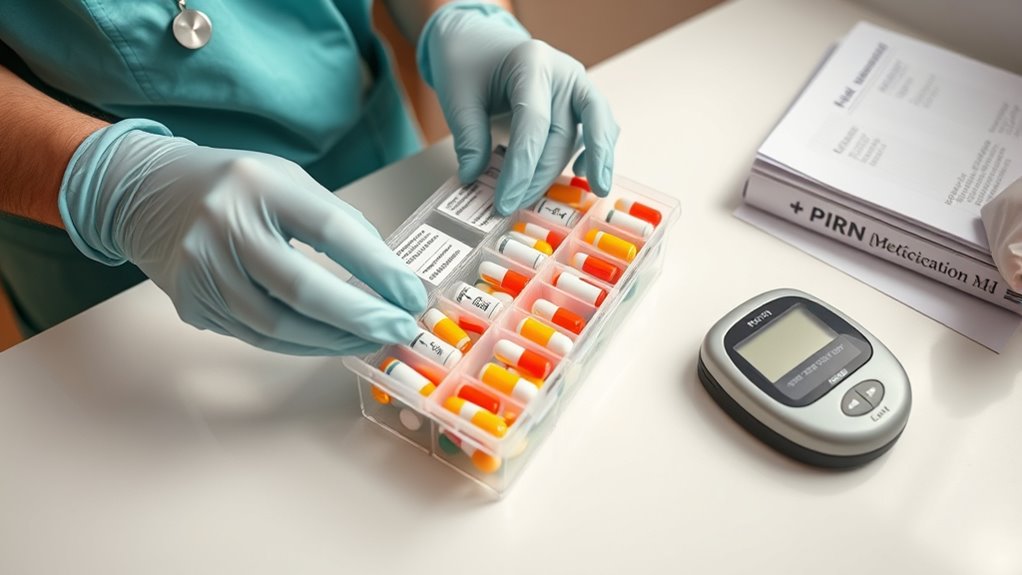To manage PRN (“as needed”) medications safely, follow clear guidelines on dosing, timing, and maximum daily limits to prevent overuse. Educate yourself or caregivers on proper administration, recognizing symptoms that signal when to take medication, and side effects to watch for. Keep detailed records of each use to monitor patterns and communicate with healthcare providers regularly. Be mindful of drug interactions or adverse effects, ensuring safe and effective relief. Continuing with these tips will help you stay confident in medication management.
Key Takeaways
- Establish clear guidelines for dosage, timing, and maximum daily limits to prevent overuse and ensure safe administration.
- Educate patients and caregivers on proper timing, dosing, and recognizing signs needing medication to promote safe use.
- Document each PRN dose accurately, including time, amount, and patient response, to monitor usage patterns.
- Regularly review and adjust PRN medication plans based on patient response and emerging clinical data.
- Monitor for potential drug interactions and adverse effects, consulting healthcare providers for safe management.
Understanding the Purpose and Types of PRN Medications

PRN medications, also known as “as needed” medications, are prescribed to provide relief for symptoms that fluctuate or occur unpredictably. You use them when symptoms like pain, anxiety, or nausea arise unexpectedly. Understanding their purpose helps you manage them effectively. These medications come in various types, tailored to address specific issues, and your healthcare provider determines the appropriate medication based on your needs. Proper medication scheduling is essential; it guarantees you take PRN doses only when necessary, avoiding overuse. Additionally, dose adjustments may be needed over time to maintain effectiveness and minimize side effects. Recognizing the importance of appropriate medication management can help prevent complications and ensure optimal symptom control. By understanding the purpose and types of PRN medications, you can better communicate with your healthcare team and ensure safe, effective symptom management.
Establishing Clear Guidelines for Use and Dosage

To guarantee safe and effective use of as-needed medications, it’s essential to establish clear guidelines for their use and dosage. You should define specific dosage limits to prevent overuse and ensure appropriate medication adjustment when needed. Clear instructions on medication timing help avoid missed doses or accidental overadministration. Set maximum daily doses to guide safe practice and prevent adverse effects. Additionally, specify how long to wait between doses, considering the medication’s onset and duration of action. Regularly review and update these guidelines based on patient response and any new clinical information. Incorporating AI in healthcare can assist in monitoring medication adherence and optimizing treatment plans. Precise directions for medication timing and dosage adjustment empower caregivers and staff to administer PRN medications safely and consistently. This approach minimizes risks and supports optimal patient outcomes.
Educating Patients and Caregivers on Proper Administration

Clear guidelines for medication use are only effective if patients and caregivers understand how to follow them properly. Patient education is essential, especially regarding medication scheduling and administration techniques. When teaching about PRN medications, emphasize when and how to take the medication, including the correct dose and timing. Make sure caregivers know how to recognize signs that indicate the medication is needed and understand any potential side effects. Use simple language and visual aids if necessary to clarify instructions. Reinforce the importance of adhering to the prescribed schedule and not exceeding the recommended dosage. Additionally, understanding advances in machine learning can help healthcare providers develop better tools for patient education and medication management. By providing thorough education, you empower patients and caregivers to manage PRN medications safely, reducing risks and promoting effective symptom relief.
Documenting and Monitoring PRN Medication Usage

Effective documentation and monitoring are essential to ensuring safe and appropriate use of PRN medications. You should implement thorough medication tracking by recording each dose administered, including time, dosage, and patient response. Usage documentation helps you identify patterns, such as frequent use or ineffective relief, which can inform care adjustments. Consistently updating records ensures a clear communication trail among healthcare providers, reducing errors and enhancing patient safety. Use standardized forms or electronic health records to streamline documentation and make information easily accessible. Regularly reviewing medication logs allows you to monitor for overuse or underuse, ensuring medications are used as intended. Maintaining awareness of dog breed characteristics can also help anticipate specific medication needs or responses, tailoring care more effectively. Accurate tracking and diligent documentation empower you to provide safe, effective care while minimizing risks associated with PRN medication administration.
Recognizing and Addressing Potential Risks and Interactions

Understanding potential risks and interactions associated with PRN medications is crucial for ensuring patient safety. You need to be alert to drug interactions that can occur when PRN drugs interact with other medications the patient is taking. These interactions can increase the risk of adverse effects or reduce medication effectiveness. Always review the patient’s medication list before administering PRN drugs, noting any known interactions. Watch for signs of adverse effects, such as unusual drowsiness, allergic reactions, or gastrointestinal issues. If you identify potential risks, consult with the healthcare team to adjust dosages or find safer alternatives. Proactive recognition and management of drug interactions help prevent complications and ensure safe, effective use of PRN medications. Additionally, understanding medication interactions can support better decision-making and enhance overall patient care.
Frequently Asked Questions
How Can Healthcare Providers Ensure Consistent Communication About PRN Use?
To guarantee consistent communication about PRN use, you should implement effective communication strategies, such as clear documentation and regular updates. Patient education plays a crucial role; you need to inform patients about when and how to take PRN medications, potential side effects, and the importance of reporting usage. Encouraging open dialogue and verifying understanding helps prevent misuse and promotes safe, consistent medication management.
What Are Best Practices for Adjusting PRN Doses Over Time?
Imagine tuning a delicate instrument, gradually adjusting the dials to perfect harmony. When you’re adjusting PRN doses over time, you should perform careful dose titration, starting low and slowly increasing as needed. Consistent patient monitoring is essential—observe for effectiveness and side effects, documenting changes meticulously. This approach guarantees safe, effective medication management, allowing you to fine-tune doses precisely while maintaining patient safety and comfort.
How Do Cultural Beliefs Influence PRN Medication Acceptance and Use?
Cultural perceptions considerably influence medication acceptance and use. You might find that some patients trust traditional remedies more than prescribed PRN medications, affecting their willingness to take them. To promote safe use, you should respect these beliefs, provide culturally sensitive education, and involve patients in decision-making. Recognizing their perspectives helps guarantee they feel comfortable with their treatment plan, leading to better adherence and safer PRN medication management.
What Role Do Electronic Health Records Play in Managing PRN Medication Data?
Electronic health records play a vital role in managing PRN medication data through digital documentation and medication tracking. You can easily record when PRN medications are administered, monitor usage patterns, and identify potential overuse or interactions. This real-time data helps you make informed decisions, improves communication among healthcare providers, and guarantees patient safety. With accurate digital documentation, you enhance the overall management of PRN medications and promote better health outcomes.
How Can Caregivers Be Supported in Recognizing Medication Effectiveness?
You can support caregivers in recognizing medication effectiveness through ongoing symptom monitoring and caregiver education. Encourage them to observe changes in symptoms closely and keep detailed records. Providing clear guidance on what improvements to expect and when to seek help boosts their confidence. Regularly updating caregivers on medication goals and potential side effects helps them make informed decisions, ensuring safe and effective PRN medication use.
Conclusion
By understanding how to manage PRN medications safely, you can prevent potential risks and guarantee effective relief when needed. But even with the best guidelines in place, there’s always a chance of unexpected interactions or side effects. Are you prepared to recognize the signs and act swiftly? Staying vigilant and informed keeps your patients safe—and the next challenge might be closer than you think. Will you be ready when it matters most?









